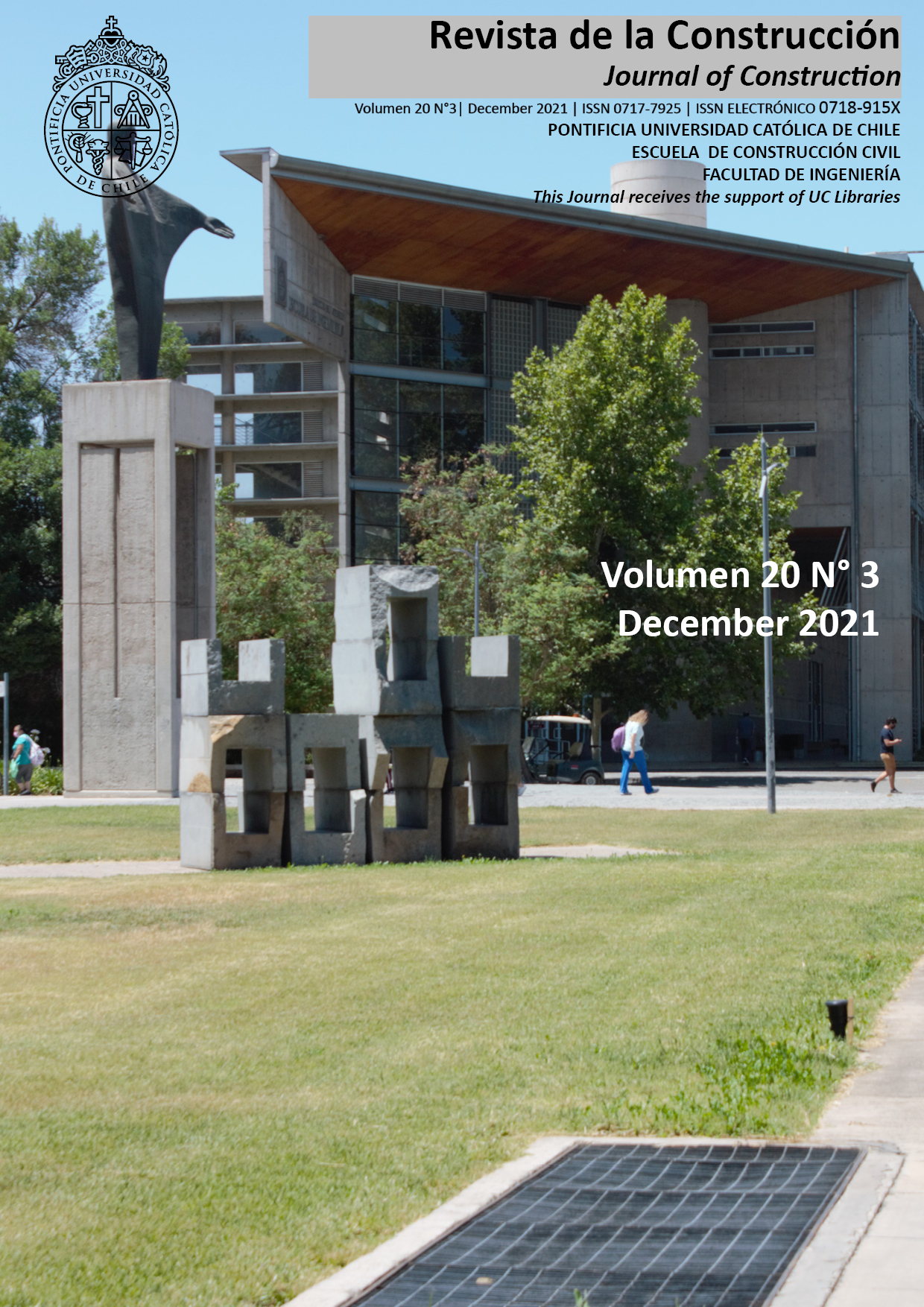The effect of strength parameters on the seismic performance of an arch dam using an uncertainty model
DOI:
https://doi.org/10.7764/RDLC.20.3.602Keywords:
arch dam, probabilistic analysis, Monte-Carlo simulation, Young modulus, modulus ratio, finite element methodAbstract
Considering the importance of the effect of concrete arch dam body strength on their seismic performance, this research evaluated the effect of Young Modulus of both the body concrete and foundation as strength parameters and examines the responses to achieve the optimal body stiffness using probabilistic and uncertainty method. The ANSYS software was used to complete the finite element analysis of the dam-reservoir-foundation system and the Monte Carlo method, which is a new method for parametric study and sensitivity analysis, was used for uncertainty analysis. For seismic analysis, the horizontal and vertical components of Northridge, San Fernando and El Centro earthquakes are separately applied in 3d directions. The earthquake components were scaled to the maximum credible level of ground motion acceleration. The foundation rock is simulated using a massless foundation model and dam-reservoir-foundation interaction is considered for seismic analysis of system. The results show the effect of the modulus of elasticity of the concrete which is directly related to the stiffness of the system. The results indicate the effect of the dam body concrete stiffness on the responses. According to the design criteria, it is possible to investigate the safety status of the dam and select the optimal state in terms of structural strength for the model. However, in order to properly select the modulus of elasticity of the concrete of the dam body, it is necessary to consider the simultaneous effect of the stiffness of the foundation and to select the optimal value.
Downloads
References
Chopra, A. K. (2012). Earthquake analysis of arch dams: factors to be considered. Journal of Structural Engineering 138(2), 205-214.
Tan, H., & Chopra, A. K. (1996) Dam-foundation rock interaction effects in earthquake response of arch dam, Journal of Structural Engineering, ASCE, 122(5), 528-538.
Westergaard, H. M. (1933). Water pressures on Dams During Earthquakes, Transactions, American Society of Civil Engineers, 98.
Kuo, J. (1982). Fluid-structure Interactions: Added Mass Computations for Incompressible Fluid, University of California, College of Engineering, Earth-quake Engineering Research Center.
Fok, K. L., & Chopra, A. K. (1986). Hydrodynamic and foundation flexibility effects in earthquake response of arch dams, Journal of Structural Engineer-ing. 112 (8), 1810-1828.
Hariri-Ardebili, M. A., & Mirzabozorg, H. (2013). Feasibility study of DEZ arch dam heightening based on nonlinear numerical analysis of existing dam, Archives of civil engineering, LIX-1, 21-49.
Heshmati, M., Hariri-Ardebili, M. A., Seyed Koldabi, S.M., & Mirzabozorg, H. (2013). Are there any difference in seismic performance evaluation criteria for concrete arch dams, Civil engineering infrastructures journal, 46(2), 233-240.
National Academy Press, (1990). Earthquake Engineering for Concrete Dams: Design, Performance, and Research Needs, Panel on Earthquake engineer-ing for Concrete Dams, Committee on Earthquake Engineering Division of Natural Hazard Mitigation, Commission on Engineering and Technical Systems, National Research Council.
Applied Technology Council (ATC), (2012). ATC-58: Guidelines for Seismic Performance Assessment of Buildings, Redwood City, CA, US.
Ferdousi, A., Gharabaghi, A.R. M., Ahmadi, M. T., Chenaghlou, M. R., & Tabrizi, M. (2014). Earthquake analysis of arch dams including the effects of foundation discontinuities and proper boundary conditions, Journal of Theoretical and Applied Mechanics, 52(3), 579-594.
Leger, P., & Boughoufalah, M. (1989). Earthquake input mechanisms for time-domain analysis of dam—foundation systems, Engineering Structures, 11(1): 37-46.
Altarejos, L., Bueno, I., & Serrano-Lombillo, A. (2012). A Methodology for estimating the probability of failure by sliding in concrete gravity dams in the context of risk analysis, Structural Safety, 36–37, 1-13.
U.S. Environmental Protection Agency, (2014). Risk Assessment Forum White Paper: Probabilistic Risk Assessment Methods and Case Studies, Probabilis-tic Risk Analysis Technical Panel. Office of the Science Advisor.
Rohaninejad, M., & Zarghami, M. (2012). Combining Monte Carlo and finite difference methods for effective simulation of dam behaviour, Advances in engineering software, 45, 197-202.
Cullen, A. C. , Frey, H. C. (1999). Probabilistic techniques in exposure assessment: a handbook for dealing with variability and uncertainty in models and inputs, Springer Science & Business Media.
Morgan, M.G., Henrion, M., & Small, M. (1992). Uncertainty: a Guide to dealing with uncertainty in quantitative risk and policy analysis, Cambridge University Press.
Risk assessment forum U.S. (1997). Environmental Protection Agency Washington, DC 20460, Risk assessment forum U.S, Guiding principal for Monte Carlo analysis.
McKay, M. D., Beckman, R. J., & Conover, W. J. (2000). A comparison of three methods for selecting values of input variables in the analysis of output from a computer code, Technometrics, 42(1), 55-61.
Pasbani Khiavi, M., Ghorbani, M. A., & Kouchaki, M. (2020). Evaluation of the effect of reservoir length on seismic behaviour of concrete gravity dams using Monte Carlo method, Numerical methods in civil engineering journal, 5(1), 1-7.
Pasbani Khiavi, M., Ghorbani, M. A., & Ghaed Rahmati, A. (2020). Seismic Optimization of Concrete Gravity Dams Using a Rubber Damper, Internation-al Journal of Acoustics and Vibration, 25 (3), 425-435.
Pasbani Khiavi, M., Feizi, A., & Ramzi, L. (2021). Effect of Strength Parameters on Seismic Performance of Elevated Tanks by Probabilistic Analysis, Journal of Hydraulic Structures, 7(1), 77-97.
Vamvatsikos, D., & Fragiadakis, M. (2010). Incremental dynamic analysis for estimating seismic performance sensitivity and uncertainty, Earthquake Engineering and Structural Dynamics, 39, 141-163.
Chakrabati, P., & Chopra, A.K. (1973). Earthquake analysis of gravity dams including hydrodynamic interaction, Earthquake Engineering and Structural Dynamics, 2, pp. 143-160.
Bathe, K . J. (1996). Finite element procedures, Upper Saddle River, New Jersey 07458.
Hall, J. F., & Chopra, A. K. (1982). Hydrodynamic effects in the dynamic response of concrete gravity dams, Earthquake engineering and structural dy-namics, 10, 333-345.
Sharan, S. K., & Gladwell, G. M. L. (1985). A general method for the dynamic response analysis of fluid-structure systems, Computers and structures, 21, 937-943.
ACI Committee 318. Building Code Requirements for Structural Concrete (ACI 318-14), (2015). An ACI Standard: Commentary on Building Code Requirements for Structural Concrete (ACI 318R-14), an ACI Report. American Concrete Institute.
Raphael, J. M. (1984). Tensile strength of concrete, Journal Proceeding, 81(2), 158-165.








